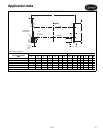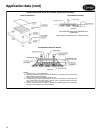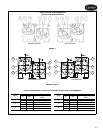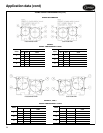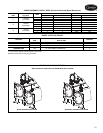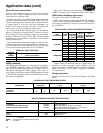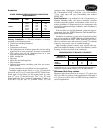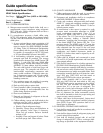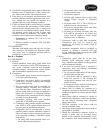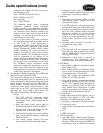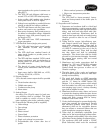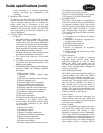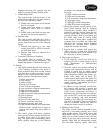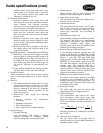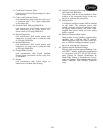
27
input terminals as the point of common cou-
pling (PCC).
b. The VFD full load efficiency shall meet or
exceed 97% at 100% VFD rated ampacity.
c. Active rectifier shall regulate unity displace-
ment power factor to 0.99 or higher.
d. Voltage boost capability to provide full motor
voltage at reduced line voltage conditions.
e. The VFD shall feature soft start, linear accel-
eration, and coast to stop capabilities.
f. Base motor frequency shall permit motor to
be utilized at nameplate voltage. Adjustable
frequency range shall permit capacity con-
trol down to 15%.
g. The VFD shall have 150% instantaneous
torque generation.
7. VFD Electrical Service (single point power):
a. The VFD shall have input circuit breaker
with minimum 65,000 amp interrupt
capacity.
b. The VFD shall have standard branch oil
pump circuit breaker to provide power for
chiller oil pump.
c. The VFD shall have standard 3 KVA control
power transformer with circuit breaker to
provide power for oil heater, VFD controls
and chiller controls.
d. The branch oil pump circuit breaker and
control power transformer shall be factory-
wired.
e. Input power shall be 380/460 vac, ±10%,
3 Phase, 50/60 Hz, ±2% Hz.
8. Discrete Outputs:
115-v discrete contact outputs shall be provided
for:
a. Circuit breaker shunt trip
b. Chilled water pump
c. Condenser water pump
d. Alarm status
9. Analog Output:
An analog (4 to 20 mA) output for head pres-
sure reference shall be provided. This signal
shall be suitable to control a 2-way or 3-way
water regulating valve in the condenser piping.
10. Protection (the following shall be supplied):
a. Under-voltage
b. Over voltage
c. Phase loss
d. Phase reversal
e. Ground fault
f. Phase unbalance protection
g. Single cycle voltage loss protection
h. Programmable auto re-start after loss of
power
i. Motor overload protection (NEMA Class 10)
j. Motor over temperature protection
11. VFD Testing:
The VFD shall be factory-mounted, factory-
wired and factory-tested on the chiller prior to
shipment.
E. Evaporator and Condenser:
1. Evaporator and condenser shall be of shell and
tube type construction, each in separate shells.
Units shall be fabricated with high-performance
tubing, steel shell and tube sheets with fabri-
cated steel waterboxes. Waterboxes shall be
nozzle-in-head type with stub out nozzles having
Victaulic grooves to allow for use of Victaulic
couplings.
2. Tubing shall be copper, high-efficiency type,
with integral internal and external enhance-
ment unless otherwise noted. Tubes shall be
nominal
3
/
4
-in. OD with nominal wall thickness
of 0.025 in. measured at the root of the fin
unless otherwise noted. Tubes shall be rolled
into tube sheets and shall be individually
replaceable. Tube sheet holes shall be double
grooved for joint structural integrity. Intermedi-
ate support sheet spacing shall not exceed
36 in. (914 mm).
3. Waterboxes and nozzle connections shall be
designed for 150 psig (1034 kPa) minimum
working pressure unless otherwise noted.
Nozzles should have grooves to allow use of
Victaulic couplings.
4. The tube sheets of the cooler and condenser
shall be bolted together to allow for field disas-
sembly and reassembly.
5. The vessel shall display an ASME nameplate
that shows the pressure and temperature data
and the “U” stamp for ASME Section VIII,
Division 1. A re-seating pressure relief valve(s)
shall be installed on each heat exchanger. If a
non-reseating type is used, a backup reseating
type shall be installed in series.
6. Waterboxes shall have vents, drains, and covers
to permit tube cleaning within the space shown
on the drawings. A thermistor type temperature
sensor with quick connects shall be factory-
installed in each water nozzle.
7. Cooler shall be designed to prevent liquid refrig-
erant from entering the compressor. Devices
that introduce pressure losses (such as mist
eliminators) shall not be acceptable because
they are subject to structural failures that can
result in extensive compressor damage.
8. Tubes shall be individually replaceable from
either end of the heat exchanger without affect-
ing the strength and durability of the tube sheet
and without causing leakage in adjacent tubes.
9. The condenser shell shall include a FLASC
(Flash Subcooler) which cools the condensed



